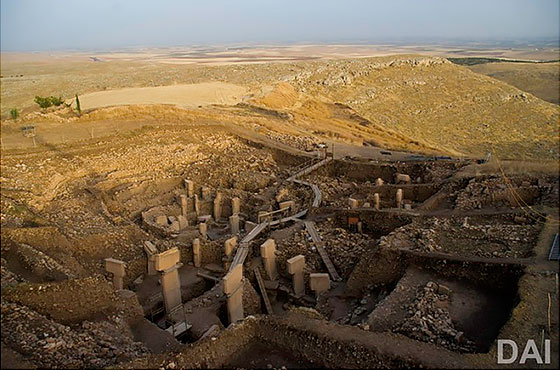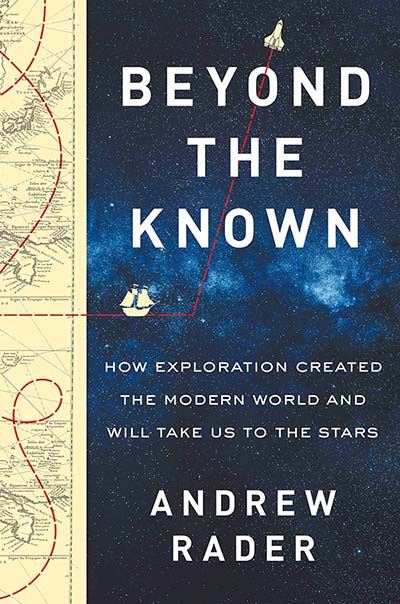SCIENCE SALON # 120
Michael Shermer with Andrew Rader — Beyond the Known: How Exploration Created the Modern World and Will Take Us to the Stars
For the first time in history, the human species has the technology to destroy itself. But having developed that power, humans are also able to leave Earth and voyage into the vastness of space. After millions of years of evolution, we’ve arrived at the point where we can settle other worlds and begin the process of becoming multi-planetary. How did we get here? What does the future hold for us? Divided into four accessible sections, Beyond the Known examines major periods of discovery and rediscovery, from Classical Times, when Phoenicians, Persians and Greeks ventured forth; to The Age of European Exploration, which saw colonies sprout on nearly continent; to The Era of Scientific Inquiry, when researchers developed brand new tools for mapping and traveling farther; to Our Spacefaring Future, which unveils plans currently underway for settling other planets and, eventually, traveling to the stars.
A Mission Manager at SpaceX with a light, engaging voice, Andrew Rader is at the forefront of space exploration. As a gifted historian, Rader, who has won global acclaim for his stunning breadth of knowledge, is singularly positioned to reveal the story of human exploration that is also the story of scientific achievement. Told with an infectious zeal for traveling beyond the known, Beyond the Known illuminates how very human it is to emerge from the cave and walk toward an infinitely expanding horizon. Rader and Shermer also discuss:
- the human nature to explore: adaptation or spandrel?
- what the Greeks and Romans knew about the world that was lost for centuries
- how dark were the Dark Ages for exploration?
- the economic and religious drivers of early exploration
- the political and practical drivers of 20th century exploration
- Mars direct or to the moon first?
- how to terraform Mars
- how to get people to the moons of the outer planets
- how to get people to the stars
- are we living in a simulation?
- should we be worried about A.I.?
Andrew Rader is a Mission Manager at SpaceX. He holds a Ph.D. in Aerospace Engineering from MIT specializing in long-duration spaceflight. In 2013, he won the Discovery Channel’s competitive television series Canada’s Greatest Know-It-All. He also co-hosts the weekly podcast Spellbound, which covers topics from science to economics to history and psychology. Beyond the Known is Rader’s first book for adults. You can find him at Andrew-Rader.com.
Listen to the podcast via Apple Podcasts, Spotify, Google Podcasts, Stitcher, iHeartRadio, and TuneIn.
You play a vital part in our commitment to promoting science and reason. If you enjoy the Science Salon Podcast, please show your support.
THE GREAT COURSES PLUS
Watch hundreds of courses & lectures when you start a free trial today. Listen or watch on your TV, laptop, tablet, and smartphone.
The Great Courses Plus makes lifelong learning and personal enrichment available to anyone, anywhere. Content-rich, unique courses provide you with a world of knowledge designed to expand your horizons, and deepen your understanding of hundreds of subjects. The Great Courses Plus has helped millions of lifelong learners take their learning to the next level.
- Sign up for a free trial.
- Find your favorite subjects and stream.

Figure 1: A view of Göbekli Tepe excavation. Photo by Nico Becker, German Archaeological Institute.
Archaeologists believed that construction of megalithic monuments were beyond the capabilities of hunter-gatherers until they discovered Göbekli Tepe, a 12,000 year old site in Turkey. Is it proof of a lost civilization, or is there another answer? This article appeared in Skeptic magazine 25.2 (2020).
The Mystery of Göbekli Tepe
A New Chapter in History
Göbekli Tepe in southeastern Turkey is one of the most significant megalithic sites in the world and perhaps the greatest archaeological enigma ever discovered. Archaeologists had once thought construction of megalithic monuments was far beyond the capabilities of hunter-gatherers. They believed that people had to invent farming prior to settling in communities. Only with sufficient food resources could people settle down and develop the social hierarchy required to construct megalithic architecture. Göbekli Tepe helped to turn such thoughts upside down.
That’s what archaeologists think anyway. Alternative archaeologists (sometimes labeled by archaeologists as pseudoarchaeologists), by contrast, see Göbekli Tepe as proof that a mysterious lost civilization or ancient aliens were responsible for its construction. They believe that combined with alleged evidence of an older Sphinx and other monuments around the world, orthodox archaeologists will finally be forced to concede they have been misled about the antiquity of humanity.
Dating to at least 12,000 years ago, Göbekli Tepe is by far the oldest and one of the largest megalithic structures on Earth. That alone makes it one of the most important archaeological sites ever discovered. It was first described by Peter Benedict as part of a joint project between the Universities of Istanbul and Chicago (1963–1972).1 Based on the lack of water it was determined it could not have been a permanent settlement. In 1995 the German archaeologist Klaus Schmidt, in conjunction with the German Archaeological Institute, began the first scientific study of Göbekli Tepe. When Schmidt started excavating, he was stunned, not by the famous T-pillars that he had already seen at Nevali Çori (27 miles away), but by the unprecedented scale of what could best be described as a megalithic mountain sanctuary. Göbekli Tepe was not built in a day. Evidence indicates the site was used for thousands of years.
For archaeologists this seemed almost impossible. The necessary planning and coordination challenged the traditional theories about the capabilities of wandering bands of hunter-gatherers. By definition they did not possess sufficient resources or social hierarchy to construct anything like Göbekli Tepe. Clearly their civilization was more complex than anyone had previously thought.
Enclosures
The scale of Göbekli Tepe is enormous. It is about 1,000 feet wide, with a maximum height of 50 feet above the plateau (Figure 1). There are multiple adjacent stone enclosures where each could crudely be described as a Turkish Stonehenge. However, the Stonehenge analogy fails to convey the majesty and significance of the site. Enclosure diameters vary from 30–100 feet and each enclosure contains two monolithic T-shaped pillars of up to 18 feet tall. It is estimated that the largest pillar weighs over 50 tons. Closer inspection reveals some of the center T-pillars are stylized human bodies with arms and hands, but no faces. The limestone pillars were quarried not far from the site. All this from only a small fraction of the site that has been excavated. There is likely much more to come. […]














